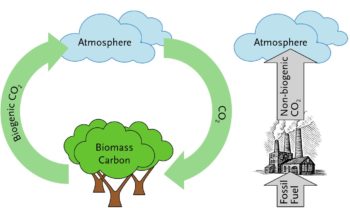Fossil vs biogenic CO2 emissions
 However, statements like “the use of woody biomass for energy will release higher levels of emissions than coal” overlook the fundamental difference between energy supply from fossil fuels and from biomass: burning fossil fuels releases carbon that has been locked up in the ground for millions of years, while burning biomass emits carbon that is part of the biogenic carbon cycle. In other words, fossil fuel use increases the total amount of carbon in the biosphere-atmosphere system while bioenergy systems operates within this system; biomass combustion simply returns to the atmosphere the carbon that was absorbed as the plants grew.*
However, statements like “the use of woody biomass for energy will release higher levels of emissions than coal” overlook the fundamental difference between energy supply from fossil fuels and from biomass: burning fossil fuels releases carbon that has been locked up in the ground for millions of years, while burning biomass emits carbon that is part of the biogenic carbon cycle. In other words, fossil fuel use increases the total amount of carbon in the biosphere-atmosphere system while bioenergy systems operates within this system; biomass combustion simply returns to the atmosphere the carbon that was absorbed as the plants grew.*
The net greenhouse gas (GHG) outcome of using biomass for energy cannot be determined by comparing emissions at the point of combustion. Instead, the biogenic carbon flows and any fossil GHG emissions associated with the bioenergy system need to be compared with the GHG emissions associated with the energy system displaced, considering also biogenic carbon flows in the absence of the bioenergy system.
*IPCC distinguishes between the slow domain of the carbon cycle, where turnover times exceed 10,000 years, and the fast domain (the atmosphere, ocean, vegetation and soil), vegetation and soil carbon have turnover times in the magnitude of 1– 100 and 10– 500 years, respectively. Fossil fuel transfers carbon from the slow domain to the fast domain, while bioenergy systems operate within the fast domain. (source: National Council for Air and Stream Improvement)


